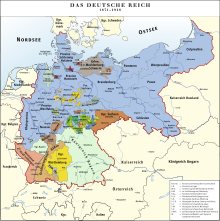- Central Germany (cultural area)
-
- For other uses, see Central Germany (disambiguation).
Central Germany (German: Mitteldeutschland, lit. "middle-Germany") is an economic and cultural region in Germany. Its exact borders depend on context, but it is often defined as being a region within the federal states of Saxony, Thuringia and Saxony-Anhalt, or a smaller part of this region (such as Leipzig and Halle).
The name dates from the German Empire, when the region was approximately in the centre of the country. Since the German Empire's eastern territories became part of Poland, "Central Germany" has been located east of the centre of the country, but the name is still often used in business, media and by the Central German Metropolitan Region.
Contents
History
 In the German Empire, 1871-1918, Saxony was in a central location
In the German Empire, 1871-1918, Saxony was in a central location
Historically also including most of Hesse, parts of Franconia and the south of Lower Saxony [1], the region is described as an area south of the linguistic Benrath line where Central German dialects were spoken. It was for centuries one of the most advanced areas in Germany, a center of both the Protestant Reformation and the 19th-century Industrial Revolution.
Until World War II, this area was seen as the middle of Germany due to it being approximately midway between Aachen and Königsberg. The Middle German Chemical Triangle was the central region of the three main German industrial areas between the Ruhr and Upper Silesia. After 1945, when Germany lost its eastern territories, the area fell into the remaining East German territory.
For decades until Chancellor Willy Brandt started his Ostpolitik, "central Germany" was used in official West German usage to denote the German Democratic Republic, by both the Christian Democratic Union and the Social Democratic Party, and by a large number of West German residents who had been expelled from the eastern provinces, who held a wide range of political views. However, after the West German government accepted the fixed eastern border with Poland in 1970, implying that parts of Poland were still "eastern Germany" was associated only with far-right and revanchist viewpoints.[citation needed]
Post-reunification
After the 1990 German reunification, however, activists (e.g. Aktion Mitteldeutschland e.V.) claimed that the larger Leipzig-Halle area would benefit from asserting an economic identity, separate from the other more rural new states of former East Germany. The use of the term "Central Germany" was meant to underline its location in Central Europe and to recall the industrial glory of the area in former times. Mainly it is used in business and the media.
Since 1991, ARD has used the term for the public regional broadcaster in Thuringia, Saxony and Saxony-Anhalt, Mitteldeutscher Rundfunk (Central German Broadcasting). The term is often used by private companies that are located around Leipzig, Halle and Dessau as well as by the Evangelical Church in Central Germany. The term is also used in sports competitions, such as the Mitteldeutsche Meisterschaften (Central German Championships).
The Central German Metropolitan Region is a regional development zone in the European METREX network. It now includes major cities in Thuringia and Saxony-Anhalt, as well as the "Saxon triangle" of cities that set up the organization in 1994 (Leipzig-Halle, Dresden and Chemnitz-Zwickau).[2]
Although most methods for determing the geographical center of Germany result in a point in "Central Germany" (for example Niederdorla in western Thuringia), the three-state area also comprises Görlitz, the easternmost town in Germany on the border with Poland.
Examples of use
- Central German Metropolitan Region (11 cities in Saxony, Thuringia and Saxony-Anhalt)
- Mitteldeutscher Rundfunk (Saxony, Thuringia and Saxony-Anhalt)
- Mitteldeutsche Zeitung, Central German Newspaper (Halle/southern Saxony-Anhalt only)
- Central German football championship (1902-1933: modern-day Saxony, Thuringia, Saxony-Anhalt with exception of the northern parts; plus Duderstadt, Neustadt bei Coburg and others[3])
- Mitteldeutscher Basketball Club (Weißenfels in Saxony-Anhalt)
- Mitteldeutsches Chemiedreieck (Halle, Merseburg and Bitterfeld in S.-Anhalt; Leipzig and Schkeuditz in Saxony)
- Evangelical Church in Central Germany (Thuringia, most of Saxony-Anhalt, some of Saxony, some of Brandenburg – see all German Evangelical churches)
See also
- East Germany (GDR)
- New states of Germany (post-reunification)
- East Central German dialects
References
- ^ König, Werner. Mitteldeutschland als geografischer Begriff in "dtv-Atlas Deutsche Sprache", December 2007, p. 120
- ^ Region Mitteldeutschland: history Retrieved 30 Oct 2010
- ^ Verband Mitteldeutscher Ballspiel-Vereine, German Wikipedia Retrieved 2 Nov 2011
External links
- Website of the mitteldeutschland campaign (German)
- Central German Metropolitan Region (English)
Categories:- Regions of Germany
Wikimedia Foundation. 2010.


